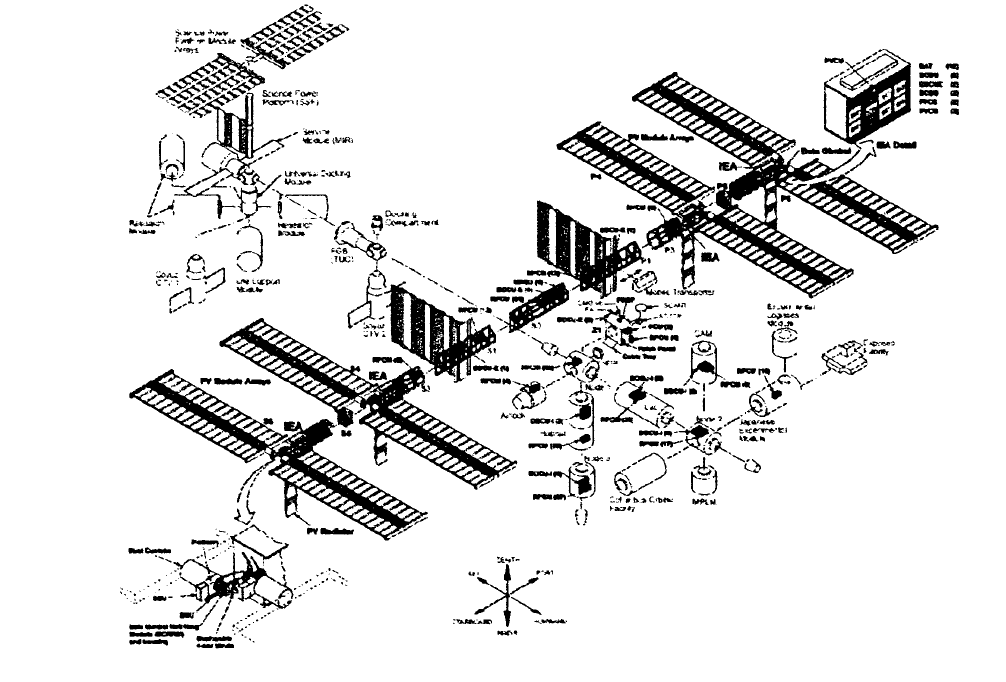Harris C.M., Piersol A.G. Harris Shock and vibration handbook
Подождите немного. Документ загружается.


The first category represents the type of systems most often dealt with in structural
dynamics and mechanical vibration. In the majority of engineering analyses, damp-
ing is assumed to be well-distributed in a manner justifying the use of normal mode
analysis techniques (see Chaps. 21 and 28, Part I). Systems in the first and second cat-
egories having more general damping features may be treated by complex modal
analysis procedures (see Chap. 28, Part I). When localized nonlinear features are
present, normal or complex mode analysis procedures may also be applied.The final
class, namely dynamic systems with distributed nonlinear features, must be treated
using numerical integration procedures. When a nonlinear system is subjected to a
slowly applied or moderately low frequency environment, implicit numerical inte-
gration is often the preferred numerical integration strategy. Alternatively, when
the dynamic environment is suddenly applied, high-frequency and/or short-lived
explicit numerical integration is often advantageous.
APPLICATION OF NORMAL MODES IN TRANSIENT
DYNAMIC ANALYSIS
The homogeneous form for the conventional linear structural dynamic formulation
[see Eq. (28.59)], with damping ignored, defines the real eigenvalue problem, that is,
[K]{Φ
n
} − [M]{Φ
n
}ω
n
2
= {0} (28.76)
where
{u} = {Φ
n
} sin (ω
n
t) (28.77)
There are as many distinct eigenvectors or modes, {Φ
n
}, as set degrees-of-freedom
for a well-defined undamped dynamic system. The eigenvalues, ω
2
n
(ω
n
= natural fre-
quency of mode n), however, are not necessarily all distinct. Individual modes or
mode shapes represent displacement patterns of arbitrary amplitude. It is conven-
ient to normalize the mode shapes (to unit modal mass) as follows:
{Φ
n
}
T
[M]{Φ
n
} = 1 (28.78)
The assembly of all or a truncated set of normalized modes into a modal matrix, [Φ],
defines the (orthonormal) modal transformation
{U} = [Φ]{q} (28.79)
where
[Φ]
T
[M][Φ] = [OR] = [I] = diagonal identity matrix
(28.80)
[Φ]
T
[K][Φ] = [Λ] = [ω
2
n
] = diagonal eigenvalue matrix
The modal transformation produces the mathematically diagonal matrix
[Φ]
T
[B][Φ] = [2ζ
n
ω
n
] = diagonal modal damping matrix (28.81)
FINITE ELEMENT MODELS 28.39
8434_Harris_28_b.qxd 09/20/2001 11:48 AM Page 28.39

only for special forms of the damping matrix. One such form, known as proportional
damping, is
[B] =α[M] +β[K] (28.82)
In reality, proportional damping is a mathematical construction that bears little
resemblance to physical reality. It is experimentally observed in many situations,
however, that the diagonal modal damping matrix is a valid approximation.
Application of the modal transformation to the dynamic equations [see Eq.
(28.59)] results in the uncoupled single degree-of-freedom dynamic equations
¨q
n
+ 2
n
ω
n
q
n
+ω
n
2
q
n
= [Φ
n
T
Γ]{F(t)} = [Γ
qn
]{F(t)} = Q
n
(t) (28.83)
The symbol ζ
n
is the critical damping ratio and [Γ
qn
] = [Φ
n
T
Γ] is the modal excitation
gain array.
The character and content of an individual normal mode, [Φ
n
], is described fun-
damentally by the geometric distribution of the displacement degrees-of-freedom.
Utilizing the mass matrix, [M], the modal momentum distribution is
{P
n
} = [M]{Φ
n
} (28.84)
and the modal kinetic energy distribution is
{E
n
} = {P
n
} {Φ
n
} = ([M]{Φ
n
}) {Φ
n
} (28.85)
where denotes term-by-term multiplication. The sum of the terms in the modal
kinetic energy vector, {E
n
}, is 1.0 when the mode is normalized to unit modal mass.
Internal structural loads and stresses, relative displacements, strains, and other
user-defined terms are calculated as recovery variables. In many cases the recovery
variables, {S}, are related to the physical displacements, {u}, through a load transfor-
mation matrix, [K
S
], specifically,
{S} = [K
S
]{u} (28.86)
A modal (displacement-based) load transformation matrix, defined by substitution
of the modal transformation, is
{S} = [Φ
KS
]{q} (28.87)
where
[Φ
KS
] = [K
S
][Φ]
The dynamic response of a structural dynamic system, described in terms of normal
modes, is computed as follows:
Step 1. Calculate the modal responses numerically with, for example, the Du-
hamel integral (see Chap. 8) given by
28.40 CHAPTER TWENTY-EIGHT, PART II
8434_Harris_28_b.qxd 09/20/2001 11:48 AM Page 28.40

q
n
(t) =
t
0
h
n
(t −τ)Q
n
(τ)dτ (28.88)
where
h
n
(t −τ) = e
−ζ
n
ω
n
(t −τ)
sin ((ω
n
1 −ζ
n
2
)(t −τ)) (28.89)
Similar relationships exist for modal velocity and acceleration.
Step 2. Calculate the physical displacement, velocity, and acceleration responses
by modal superposition using Eq. (28.79) and calculate loads using Eq. (28.87).
It should be noted that the calculation of modal responses to harmonic and random
excitation environments follows strategies paralleling steps 1 and 2. These matters
will be discussed at the end of this chapter.
MODAL TRUNCATION
A common practice in structural dynamics analysis is to describe a system response
in terms of a truncated set of lowest-frequency modes. The selection of an appropri-
ate truncated mode set is accomplished by a normalized displacement, shock
response spectrum analysis (see Chap. 23) of each force component in the excitation
environment, {F(t)}, and establishment of the cut-off frequency, ω*. All modal
responses for systems with a natural frequency, ω
n
>ω*, will respond quasi-statically.
Therefore, the dynamic response will be governed by the truncated set of modes,
[Φ
L
], with natural frequencies below ω*.The remaining set of high-frequency modes
is denoted as [Φ
H
]. Therefore, the partitioned modal relationships are
{u} = [Φ
L
]{q
L
} + [Φ
H
]{q
H
}
{ ¨q
L
} + [2
L
ω
L
]{
q
L
} + [ω
2
L
]{q
L
} = [Φ
T
L
Γ]{F(t)} (28.90)
[ω
2
H
]{q
H
} ≈ [Φ
T
H
Γ]{F(t)}
Since the high-frequency modal equations are algebraic, the modal transformation
becomes
{u} = [Φ
L
]{q
L
} + [Ψ
ρ
]{F(t)} (28.91)
where [Ψ
ρ
] is the residual flexibility matrix defined as
[Ψ
ρ
] = [Φ
H
][ω
2
H
]
−1
[Φ
H
]
T
[Γ] (28.92)
The computation of structural dynamic response employing a truncated set of
modes often is inaccurate if the quasi-static response associated with the high-
ω
n
1 −ζ
n
2
FINITE ELEMENT MODELS 28.41
8434_Harris_28_b.qxd 09/20/2001 11:48 AM Page 28.41

frequency modes is not accounted for. This being the case, it appears that all modes
must be computed as indicated in Eq. (28.92). Such a requirement results in an
excessive computational burden for large-order finite element models.
Residual Mode Vectors and Mode Acceleration. The significance of residual
flexibility (quasi-static response of high-frequency modes) is well established,
11
as
are methods for the efficient definition of residual vectors.
12
The basic definition for
residual flexibility, using all of the high-frequency modal vectors, is computationally
inefficient for large-order models. Therefore, procedures that do not explicitly
require knowledge of the high-frequency modes have been developed.
The most fundamental procedure for deriving residual vectors forms residual
shape vectors as the difference between a complete static solution and a static solu-
tion based on the low-frequency mode subset.The complete static solution for unit-
applied loads, using a shifted stiffness (allowing treatment of an unconstrained
structure), is
[Ψ
S
] = [K +λ
S
M]
−1
[Γ] (28.93)
where λ
S
is a small “shift” used for singular stiffness matrices. For nonsingular stiff-
ness, the shift is not required. The corresponding truncated, low-frequency mode
static solution is
[Ψ
L
] = [Φ
L
][ω
2
L
+λ
S
]
−1
[Φ
L
]
T
[Γ] (28.94)
Therefore, the residual vectors are
[Ψ
ρ
] = [Ψ
S
] − [Ψ
L
] = [K +λ
S
M]
−1
[Γ] − [Φ
L
][ω
2
L
+λ
S
]
−1
[Φ
L
]
T
[Γ] (28.95)
Note that the high-frequency modes are not explicitly required in this formulation.
Therefore the excessive computational burden for large-order finite element mod-
els is mitigated.
An alternative strategy, which automatically compensates for modal truncation,
is the mode acceleration method.
13
The basis for this strategy is the substitution of
truncated expressions for acceleration and velocity in the system dynamic equations,
which results in
[K]{u} = [Γ]{F} − [M][Φ
L
]{ ¨q
L
} − [B][Φ
L
]{
q
L
} (28.96)
In most applications, the term with modal velocity is ignored. The static solution of
the above equation, at each time point, produces physical displacements, which
include the quasi-static effects of all high-frequency modes.
Load Transformation Matrices. Recovery of structural loads is often organized
by a definition of the load transformation matrices (LTMs).
14
When residual mode
vectors are employed, Eqs. (28.91) and (28.86) are combined to define the displace-
ment LTM relationship
{S} = [LTM
q
]{q} + [LTM
F
]{F} (28.97)
28.42 CHAPTER TWENTY-EIGHT, PART II
8434_Harris_28_b.qxd 09/20/2001 11:48 AM Page 28.42

where
[LTM
q
] = [K
S
][Φ
L
], [LTM
F
] = [K
S
][Ψ
ρ
] (28.98)
When the mode acceleration method is employed, Eqs. (28.96) and (28.86) are com-
bined to define the mode acceleration LTM relationship
{S} = [LTM
A
]{¨q} + [LTM
V
]{
q} + [LTM
AF
]{F} (28.99)
where
[LTM
A
] =−[K
S
][K
−1
MΦ
L
]
[LTM
V
] =−[K
S
][K
−1
BΦ
L
] (28.100)
[LTM
F
] = [K
S
][K
−1
Γ]
In practice, [LTM
V
] is generally ignored. Mode acceleration LTMs are used exten-
sively in the aeronautical and space vehicle industries, while their mode displace-
ment (and residual vector)–based counterpart is rarely applied.
APPLIED LOADS AND ENFORCED MOTIONS
Dynamic excitation environments sometimes are described in terms of specified
foundation or boundary motions, for example, in the study of structural dynamic
response to seismic excitations (see Chap. 24). In such situations, the physical dis-
placement array is partitioned into two subsets as follows:
{u} =
=
(28.101)
The conventional linear structural dynamic formulation is expressed in partitioned
form as
+
+
=
(28.102)
Using the partitioned stiffness matrix, the transformation from absolute to relative
response displacements is
=
=
(28.103)
Moreover, this transformation may be expressed in modal form by substituting the
lowest-frequency modes associated with the interior eigenvalue problem, which fol-
lows the relationships already discussed in Eqs. (28.76) through (28.81), that is,
[K
ii
]{Φ
in
} = [M
ii
]{Φ
in
}ω
in
2
,{u
i
} = [Φ
i
]{q
i
} (28.104)
u
ir
u
b
Ψ
ib
I
bb
I
ii
0
bi
u
ir
u
b
−K
−1
ii
K
ib
I
bb
I
ii
0
bi
u
i
u
b
F
i
F
b
u
i
u
b
K
ib
K
bb
K
ii
K
bi
u
i
u
b
B
ib
B
bb
B
ii
B
bi
ü
i
ü
b
M
ib
M
bb
M
ii
M
bi
interior motions
boundary motions
u
i
u
b
FINITE ELEMENT MODELS 28.43
8434_Harris_28_b.qxd 09/20/2001 11:48 AM Page 28.43

By combining Eqs. (28.103) and (28.104), the modal reduction transformation is
=
(28.105)
Substitution of this transformation into the partitioned dynamic equation set, Eq.
(28.102), results in
+
+
=
(28.106)
The terms in the above equation set have the following significance:
1. [P
ib
] is the modal participation factor matrix. Its terms express the degree of exci-
tation delivered by individual foundation accelerations. Moreover, its transpose
describes the degree of foundation reaction loads associated with individual
modal accelerations. The term-by-term product [P
ib
] [P
ib
], called the modal
effective mass matrix, is often used to evaluate the completeness of a truncated
set of modes.
2. [M′
bb
] is the boundary mass matrix. When the boundary motions are sufficient to
impose all six rigid body motions (in a statically determinate or redundant man-
ner), this matrix expresses the complete rigid body mass properties of the mod-
eled system.
3. [K′
bb
] is the boundary stiffness matrix. When the boundary motions are sufficient
to impose all six rigid body motions in a statically determinate manner, this
matrix is null. If the boundary is statically indeterminate, the boundary stiffness
matrix will have six singularities associated with the six rigid body motions. In
rare situations, additional singularities will (correctly) be present if the structural
system includes mechanisms.
4. Critical evaluation of the properties of [M′
bb
] and [K′
bb
] is an effective means for
model verification.
5. In most situations, damping is not explicitly modeled. Therefore the boundary
damping matrix, [B′
bb
], will not be computed.
When the dynamic excitation environment consists entirely of prescribed boundary
motions, ({F
i
} = {0}), Eq. (28.106) may be expressed in the following convenient form:
{ ¨q
i
} + [2ζ
i
ω
i
]{
q
i
} + [ω
i
2
]{q
i
} =−[P
ib
]{ü
b
} (modal response)
(28.107)
{F
b
} = [M′
bb
]{ü
b
} + [K′
bb
]{u
b
} + [P
bi
]{¨q
i
} (boundary reactions)
The accurate recovery of structural loads is preferably accomplished with the mode
acceleration method. The load transformation matrix relationship for this situation
takes the following form (ignoring damping):
{S} = [LTM
¨q
]{ ¨q} + [LTM
ü
b
]{ü
b
} + [LTM
u
b
]{u
b
} + [LTM
F
i
]{F
i
} (28.108)
The above relationships are commonly used in seismic structural analysis and equip-
ment shock response analysis.
Φ
i
T
F
i
Ψ
T
ib
F
i
+ F
b
q
i
u
b
0
ib
K′
bb
ω
i
2
0
bi
q
i
u
b
0
ib
B′
bb
2ζ
i
ω
i
0
bi
¨q
i
ü
b
P
ib
M′
bb
I
ii
P
bi
q
i
u
b
Ψ
ib
I
bb
Φ
i
0
bi
u
i
u
b
28.44 CHAPTER TWENTY-EIGHT, PART II
8434_Harris_28_b.qxd 09/20/2001 11:48 AM Page 28.44

STRATEGIES FOR DEALING WITH LARGE-ORDER MODELS
The capabilities of computer resources and commercial finite element software have
continually increased making very large-order (∼10
6
degrees-of-freedom or more)
finite element models a practical reality. A variety of numerical analysis strategies
have been introduced to efficiently deal with these large-order models.
In 1965, what is popularly known as the Guyan reduction method
15
was intro-
duced. This method employs a static reduction transformation based on the model
stiffness matrix to consistently reduce the mass matrix. By subdividing the model
displacements into analysis (a) and omitted (o) subsets, the static reduction trans-
formation is
=
{u
a
} (28.109)
By applying this transformation to the dynamic system, an approximate reduced
dynamic system for modal analysis is defined as
[M
aa
]{ü
a
} + [K
aa
]{u
a
} = {0} (28.110)
where
[M
aa
] =
T
[K
aa
] =
T
(28.111)
The reduced approximate mass and stiffness matrices are generally fully populated,
in spite of the fact that the original system matrices are typically quite sparse. The
effective selection of an appropriate analysis set, {u
a
}, is a process requiring good
physical intuition. A recently introduced two-step procedure
16
automatically iden-
tifies an appropriate analysis set. The Guyan reduction method is no longer a
favored strategy for dealing with large-order dynamic systems due to the develop-
ment of powerful numerical procedures for very large-order sparse dynamic sys-
tems. It continues to be employed, however, for the definition of test-analysis
models (TAMs) which are used for modal test planning and test-analysis correla-
tion analyses (see Chap. 41). Numerical procedures, which are currently favored for
dealing with modern large-order dynamic system modal (eigenvalue) analyses, are
(1) the Lanczos method
17
(refined and implemented by many other developers)
and (2) subspace iteration.
8
Segmentation of Large-Order Dynamic Systems. Many dynamic systems,
such as aircraft, launch vehicle–payload assemblies, spacecraft, and automobiles,
naturally lend themselves to substructure segmentation (see Fig. 28.9). Numerical
analysis strategies, which exploit substructure segmentation, were originally intro-
duced to improve the computational efficiency of large-order dynamic system analy-
sis. However, advances in numerical analysis of very large-order dynamic systems
have reduced the need for substructure segmentation. The enduring utilization of
substructure segmentation, especially in the aerospace industry, is a result of the fact
that substructure models provide cooperating organizations with a standard means
for sharing and integrating subsystem data. It should also be noted that some
research efforts in the area of parallel processing are utilizing mature substructure
I
aa
−K
−1
oo
K
oa
K
ao
K
oo
K
aa,o
K
oa
I
aa
−K
−1
oo
K
oa
I
aa
−K
−1
oo
K
oa
M
ao
M
oo
M
aa,o
M
oa
I
aa
−K
−1
oo
K
oa
I
aa
−K
−1
oo
K
oa
u
a
u
o
FINITE ELEMENT MODELS 28.45
8434_Harris_28_b.qxd 09/20/2001 11:48 AM Page 28.45

FIGURE 28.9 International space station substructure segmentation.
28.46
8434_Harris_28_b.qxd 09/20/2001 11:48 AM Page 28.46

analysis concepts. Each designated substructure (which also may be termed a super-
element) is defined in terms of interior, {u
i
}, and boundary, {u
b
}, displacement sub-
sets. Specific types of modal analysis strategies are employed to reduce or condense
the individual substructures to produce modal components.
The Craig-Bampton Modal Component. The most popularly employed modal
component type, the Craig-Bampton
18
(or Hurty
19
) component, is defined by Eqs.
(28.101) through (28.106) and (28.108). The undamped key dynamic equations
describing this component are as follows:
1. The Craig-Bampton reduction transformation (boundary-fixed interior modes
and boundary deflection shapes) is identical to Eq. (28.105), that is,
=
(28.112)
2. The Craig-Bampton mass and stiffness matrices, from Eq. (28.106), are
+
=
(28.113)
The MacNeal-Rubin Modal Component. The MacNeal-Rubin
12,20
component
reduction transformation consists of a truncated set of free boundary modes and
quasi-static residual vectors associated with unit loads applied at the boundary
degrees-of-freedom. The key dynamic equations describing this component are as
follows:
1. The MacNeal-Rubin reduction transformation (boundary-free component
modes and residual vectors) is
=
(28.114)
Noting that there are as many residual vectors as boundary degrees-of-freedom,
the above transformation may be expressed in terms of the modal and boundary
degrees-of-freedom, that is,
=
(28.115)
2. The MacNeal-Rubin mass and stiffness matrices: Using the first reduction
transformation form [see Eq. (28.114)], the undamped component mode equations
are of the form
+
=
(28.116)
When the second reduction transformation form [see Eq. (28.115)] is employed,
the component mode equations are of the fully coupled form
+
=
(28.117)
0
0
q
i
u
b
K′
ib
K′
bb
K′
ii
K′
bi
¨q
i
ü
b
M′
ib
M′
bb
M′
ii
M′
bi
0
0
q
i
u
ρ
0
iρ
K
ρρ
ω
i
2
0
ρi
¨q
i
ü
ρ
0
iρ
M
ρρ
I
ii
0
ρi
q
i
u
b
Ψ
iρ
Ψ
−1
bρ
I
bb
Φ
ii
−Ψ
iρ
Ψ
−1
bρ
Φ
bi
0
bi
u
i
u
b
q
i
u
ρ
Ψ
iρ
Ψ
bρ
Φ
ii
Φ
bi
u
i
u
b
0
0
q
i
u
b
0
ib
K′
bb
ω
i
2
0
bi
¨q
i
ü
b
P
ib
M′
bb
I
ii
P
bi
q
i
u
b
Ψ
ib
I
bb
Φ
i
0
bi
u
i
u
b
FINITE ELEMENT MODELS 28.47
8434_Harris_28_b.qxd 09/20/2001 11:48 AM Page 28.47

The second form of the MacNeal-Rubin mass and stiffness matrices is preferred
for automated assembly of modal components.
The Mixed Boundary Modal Component. A more general type of modal com-
ponent may be defined employing fixed- and free-boundary degree-of-freedom sub-
sets.
21
The reduced component mass and stiffness matrices associated with this
component are fully coupled, having a form similar to Eq. (28.117).
Each of the above three modal component types employs a truncated set of sub-
system modes. The frequency band, which determines an adequate set of subsystem
modes, is related to the base frequency band of the expected dynamic environment.
In particular, a generally accepted standard for the modal frequency band defines
the cut-off frequency as 1.4f* (see the discussion on Cut-Off Frequency and Grid
Spacing f*).
COMPONENT MODE SYNTHESIS STRATEGIES
Two alternative strategies for component mode synthesis are generally accepted in
industry. The first strategy views all substructures as appendages. The second alter-
native views substructures as appendages, which attach to a common main body.
General Method 1: Assembly of Appendage Substructures. The boundary
degrees-of-freedom for each component of a complete structural assembly map
onto an assembled structure boundary (collector, c) array, that is,
{u
b
} = [T
bc
]{u
c
} (28.118)
Therefore, each component’s reduction transformation is expressed in the assem-
bled (collector) degrees-of-freedom as
=
(28.119)
where Ψ
ii
represents the upper left modal transformation partition for the particular
modal component type. Application of this transformation to Eq. (28.113) or
(28.117) results in
+
=
(28.120)
The format of the assembled system dynamic equations, shown here for an assembly
of three components denoted as 1, 2, and 3, is
+
=
(28.121)
The system normal modes are calculated from the above equation where the final
system mode transformation (which decouples the system mass and stiffness matri-
ces) is
0
0
0
0
q
1
q
2
q
3
u
C
K′
1C
K′
2C
K′
3C
K′
CC
K′
33
K′
C3
K′
22
K′
C2
K′
11
K′
C1
¨q
1
¨q
2
¨q
3
ü
C
M′
1C
M′
2C
M′
3C
M′
CC
M′
33
M′
C3
M′
22
M′
C2
M′
11
M′
C1
0
0
q
i
u
c
K′
ic
K′
cc
K′
ii
K′
ci
¨q
i
ü
c
M′
ic
M′
cc
M′
ii
M′
ci
q
i
u
c
Ψ
ib
T
bc
T
bc
Ψ
ii
0
bi
u
i
u
b
28.48 CHAPTER TWENTY-EIGHT, PART II
8434_Harris_28_b.qxd 09/20/2001 11:48 AM Page 28.48
